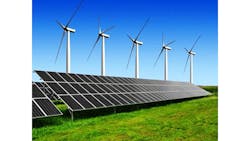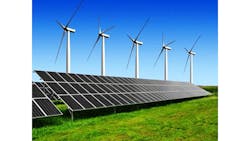Stanford Engineers Offer Plan to Convert U.S. to 100% Clean, Renewable Energy by 2050
One potential way to combat ongoing climate change, eliminate air-pollution mortality, create jobs, and stabilize energy prices involves converting the world’s entire energy infrastructure to run on clean, renewable energy.
This is a daunting challenge. But now, in a new study, Mark Z. Jacobson, a professor of civil and environmental engineering at Stanford University, and colleagues, including UC Berkeley researcher Mark Delucchi, are the first to outline how each of the 50 states can achieve such a transition by 2050. The 50-individual-state plans call for aggressive changes to both infrastructure and the ways we currently consume energy, but indicate that the conversion is technically and economically possible through the widescale implementation of existing technologies.
“The main barriers are social, political, and getting industries to change. One way to overcome the barriers is to inform people about what is possible,” Jacobson said. “By showing that it’s technologically and economically possible, this study could reduce the barriers to a large-scale transformation.”
The study is published in the online edition of Energy and Environmental Sciences. An interactive map summarizing the plans for each state is available at www.thesolutionsproject.org.
The Methodology
Jacobson and his colleagues started by taking a close look at the current energy demands of each state, and how those demands would change under business-as-usual conditions by the year 2050. To create a full picture of energy use in each state, they examined energy usage in four sectors: residential, commercial, industrial, and transportation.
For each sector, they then analyzed the current amount and source of the fuel consumed— coal, oil, gas, nuclear, renewables—and calculated the fuel demands if all fuel usage were replaced with electricity. This is a significantly challenging step—it assumes that all the cars on the road become electric, and that homes and industry convert to fully electrified heating and cooling systems. But Jacobson said that their calculations were based on integrating existing technology, and the energy savings would be significant.
“When we did this across all 50 states, we saw a 39% reduction in total end-use power demand by the year 2050,” Jacobson said. “About six percentage points of that is gained through efficiency improvements to infrastructure, but the bulk is the result of replacing current sources and uses of combustion energy with electricity.”
The next step involved figuring out how to power the new electric grid. The researchers focused on meeting each state’s new power demands using only the renewable energies—wind, solar, geothermal, hydroelectric, and tiny amounts of tidal and wave—available to each state.
They analyzed each state’s sun exposure, and how many south-facing, non-shaded rooftops could accommodate solar panels. They developed and consulted wind maps and determined whether local offshore wind turbines were an option. Geothermal energy was available at a reasonable cost for only 13 states. The plan calls for virtually no new hydroelectric dams, but does account for energy gains from improving the efficiency of existing dams.
The Results
The report lays out individual roadmaps for each state to achieve an 80% transition by 2030, and a full conversion by 2050. Jacobson said that several states are already on their way. Washington, for instance, could make the switch to full renewables relatively quickly, thanks to the fact that more than 70% of its current electricity comes from existing hydroelectric sources. That translates to about 35% of the state’s all-purpose power if Washington were 100% electrified; wind and solar could fill most of the remainder.
Iowa and South Dakota are also well-positioned, as they already generate nearly 30% of their electricity from wind power. California, which was the focus of Jacobson’s second single-state roadmap to renewables after New York, has already adopted some of his group’s suggestions and has a plan to be 60% electrified by renewables by 2030.
The plan calls for no more than 0.5% of any state’s land to be covered in solar panels or wind turbines. The upfront cost of the changes would be significant, but wind and sunlight are free. So the overall cost spread over time would be roughly equal to the price of the fossil fuel infrastructure, maintenance and production.
“When you account for the health and climate costs—as well as the rising price of fossil fuels—wind, water, and solar are half the cost of conventional systems,” Jacobson said. “A conversion of this scale would also create jobs, stabilize fuel prices, reduce pollution-related health problems, and eliminate emissions from the United States. There is very little downside to a conversion, at least based on this science.”
Jacobson said that if the conversion is followed exactly as his plan outlines, the reduction of air pollution in the U.S. could prevent the deaths of approximately 63,000 Americans who die from air pollution-related causes each year. It would also eliminate U.S. emissions of greenhouse gases produced from fossil fuel, which would otherwise cost the world $3.3 trillion a year by 2050.
About the Author

Sam Davis Blog
Editor-In-Chief - Power Electronics
Sam Davis was the editor-in-chief of Power Electronics Technology magazine and website that is now part of Electronic Design. He has 18 years experience in electronic engineering design and management, six years in public relations and 25 years as a trade press editor. He holds a BSEE from Case-Western Reserve University, and did graduate work at the same school and UCLA. Sam was the editor for PCIM, the predecessor to Power Electronics Technology, from 1984 to 2004. His engineering experience includes circuit and system design for Litton Systems, Bunker-Ramo, Rocketdyne, and Clevite Corporation.. Design tasks included analog circuits, display systems, power supplies, underwater ordnance systems, and test systems. He also served as a program manager for a Litton Systems Navy program.
Sam is the author of Computer Data Displays, a book published by Prentice-Hall in the U.S. and Japan in 1969. He is also a recipient of the Jesse Neal Award for trade press editorial excellence, and has one patent for naval ship construction that simplifies electronic system integration.

